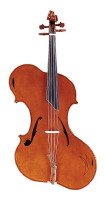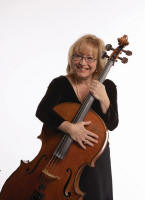Musician, Protect Thyself:
A Few Ounces of Prevention
By Janet Horvath
May 31, 2012
 Musicians: Is your body at peace—or in pieces?
Musicians: Is your body at peace—or in pieces?
According to a recent study in the journal Biological Psychiatry, daily stress literally chews holes in our brains. As musicians, then, it stands to reason that our stressful and unrelenting schedules put us at high risk for some…unpleasant consequences.
Admit it—you’ll do anything to produce that perfect performance, physical pain and mental fatigue notwithstanding. Keep it up and those consequences will be severe enough to remove you from the game altogether.
Elite athletes of the small muscles
Mastering a musical instrument is an amazing achievement, requiring years of training and torturous, often tedious, amounts of practice. Our goal is to create beauty, to transport our audiences with skill and passion. We are elite athletes of the small muscles and demand the utmost precision, coordination, fluency, speed, and endurance from our bodies.
See Heavy Lifting: Works of Notorious Notes
Unlike the typical athlete or dancer, whose careers can’t continue much past their mid-30s, if that, we musicians can have unusually long careers. But only if we take great care along the way.
Consider the icons of long careers:
- Bud Herseth, recognized as the world’s greatest symphonic trumpet player, principal trumpet for 53 years of the Chicago Symphony Orchestra
- Joseph Silverstein, concertmaster of the Boston Symphony for 22 years
- Richard Horowitz, who made the timpani sing all through his 66 years with the Met Orchestra Arnold Jacobs, tuba player with the CSO for 44 years
- Artur Rubinstein, pianist extraordinaire into his 90s
They began their careers in the old days…when orchestras had seasons, when musicians had to travel by train or ship and there was time between gigs.
Today, those same orchestras are full-time with virtually yearround seasons. Even freelancers seek to play constantly to earn a living. No wonder the incidence(s) of injury are on the rise— and those are just the players willing to admit to it. Many are reluctant to speak up for fear they will be considered damaged goods.
How can we assure long, injury-free careers?
Playing involves an awesome amount of repetition [see sidebar, Heavy Lifting: Works of Notorious Notes]. When poor and awkward postures, excessive force or tension, and physical and emotional stress are added to the mix, injury can and does occur.
The most common problem is repetitive strain injury (RSI), or overuse, a loose term applied when body tissues have been stressed beyond their biological limits. After years of overuse, wear and tear and insufficient recovery time, our muscles, tendons, and tissues may reach a point where they simply are done. Chronic pain ensues.
The Vicious Cycle and How to Avoid It
Typically, we continue to play through the pain, perhaps even blaming ourselves for faulty technique. The show must go on, right? So, we work harder to compensate for the weakness, further decreasing our range of motion, increasing soreness, and perhaps even losing feeling in the afflicted area. Brass players make their music with bruised lips; string players re-finger or grab the bow harder, cock or twist their torsos, lower the instruments to baby a painful shoulder; percussionists lean in farther, stressing their backs to save a sore arm. We end up compromising our posture and technique and stressing other areas, which then leads to further
injury—and the vicious cycle is well underway.
If you end up at this point, you will need to seek immediate treatment [see Clinics and Medical Practioners]. In the spirit of “an ounce of prevention,” here are some important tips for maintaining your chops over a long career.
The Vicious Cycle =
Force + Tension + Repetition + Poor Posture + No Rest
A Few Onstage Tricks
You can do any of these unobtrusively, some even while you are playing.
Attention Orchestra Management : You Can Help
1. Don’t Sit Still!
We have been taught to sit like statues! Static postures and holding our instruments cause tension to build. Here are a few ways to keep moving while seated:
- Pull in your chin and slowly roll your head forward, stretching the back of your neck.
- Turn your head from side to side and tilt your head ear to shoulder.
- Lower and uncurl your arms and let them hang whenever possible.
- Periodically shrug or roll your shoulders.
- Circle your wrists and thumbs.
- Interlace your fingers in front of you, turn your palms outward, and stretch your arms forward.
- Bend your elbows, placing your palms together as in prayer.
- Keeping your palms together and slowly lower your hands toward the floor.
- Stretch your shoulder and pectorals. Reach behind you with one arm to grab the chair frame, keeping your arm as close to shoulder height as possible. Repeat with the other arm.
- Stretch your pectorals. If you can hold your instrument between your legs, reach behind your back with both arms and grab the chair frame. Lean forward.
- Reach behind you and bend your elbow and try to touch between your shoulder blades, palm facing outward (a move easily done during bows).
- Clasp your hands, interlacing your fingers behind you, and gently lift your arms, pulling your shoulders back.
Don’t forget your lower extremities:
- Move your feet. Periodically turn your knees and thighs inward.
- Roll your pelvis. Adjust your seating. Squeeze your buttocks.
2. Make a Face
Did you know that clenching your teeth can cause severe ear pain and damage to your jaw joints (a.k.a. temporomandibular joints or TMJ)? To avoid face and jaw tension, release your jaws by making a fish face, doing an “air mouthwash” or by opening your mouth.
3. Breathe
Think “lips together, teeth apart.” Take deep slow breaths through your nose and exhale quickly through your mouth. At the same time pull in your abs to give yourself a lumbar stretch.
4. Sit Up
Studies indicate that sitting all day is bad for your health. The best position for your back is actually the horse-riding position. When you sit, your knees should descend from your hips so that the lumbar curve in your back can be maintained and your weight is forward and on your feet. So look for a chair that is knee height or higher when you stand next to it.
5. Stand Up
For those of you who stand to play, bend your knees slightly and avoid leaning forward or backward. Sitting or standing immobile is a risk factor for injury. Keep moving.
6. Speak Up
Effective rehearsals and exciting performances require the best possible environment. Seek solutions before pain sets in. Ask for ergonomic chairs. Request better lighting, proper temperatures, hearing protection, and favorable space.
A Few (More) Solutions
 Sometimes, our instruments require awkward postures and unnatural holding positions. Unfortunately some of these come with the territory. If you must stretch to reach a chord, release it as quickly as possible and use the least force necessary. Lower your instrument when you can. Some manufacturers are ergonomically adapting instruments: woodwind and brass makers are moving or extending keys and making the instruments lighter; string instruments’ shoulders are being shaved for easier access to high positions; percussion sticks are being made longer so that percussionists don’t have to lean or reach. [see left: The Pellegrina viola is an example of an ergonomically adapted instrument]
Sometimes, our instruments require awkward postures and unnatural holding positions. Unfortunately some of these come with the territory. If you must stretch to reach a chord, release it as quickly as possible and use the least force necessary. Lower your instrument when you can. Some manufacturers are ergonomically adapting instruments: woodwind and brass makers are moving or extending keys and making the instruments lighter; string instruments’ shoulders are being shaved for easier access to high positions; percussion sticks are being made longer so that percussionists don’t have to lean or reach. [see left: The Pellegrina viola is an example of an ergonomically adapted instrument]
Exercise can slow and even reverse both the brain’s physical decay and stress and muscle wear and tear. Include a stress-reducing and strengthening regimen to your daily routine. Above all, listen to your body.

Janet Horvath, associate principal cello of the Minnesota Orchestra, is a soloist, chamber musician, award-winning advocate for injury prevention, lecturer, and author of Playing (Less) Hurt—An Injury Prevention Guide For Musicians.
Copyright © 2025, Musical America